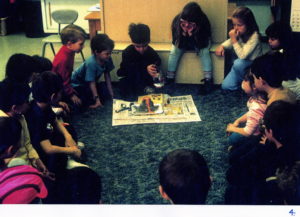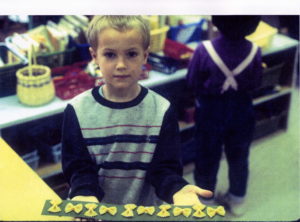
All people need success to prosper. A continual series of failures, if experienced in the school, can lead to a negative self-image, loss of face, loss of desire to continue to participate, and an urge to seek this needed success outside of the school situation. A school situation should be flexible and divergent enough to allow each person to regularly find some measure of success (VDE, 1968, p5.).
Discussion with other children and with adults is one of the principal ways in which children check their concepts against those of others and build up an objective view of reality. There is every justification for conversation which is a characteristic feature of the contemporary primary school. One of the most important responsibilities of teachers is to help children to see order and pattern in experience, and to extend their ideas by analogies and by the provision of suitable vocabulary. Rigid division of the curriculum into subjects tends to interrupt children’s trains of thought and of interest and to hinder them from realizing the common elements in problem solving (Plowden, V1, 197).
Within the…vertically grouped classroom…there is always a wide range of work going forward, and because of this the educational climate is both richer and more stimulating than that in the traditional classroom. There are no arbitrary limits to learning; verbalization and symbolization are correspondingly greater. The output of effort and achievement is impressive, but the children are not in competition with one another; they are absorbed in maximum personal effort. Experience in a community of this kind makes an important contribution to the oral development of the children – through cooperating, sharing, making mistakes without being a failure, taking responsibility, and using sympathy and imagination in dealing with others (Rogers, V. p53).
Coming to Vermont
When I came to Vermont, I quickly became immersed in the progressive ferment that enveloped Vermont education in the early 1970’s. The Vermont State Board of Education, led by Harvey Scribner, a visionary Commissioner of Education, had adopted a framework for learning called “The Vermont Design for Education.” The Vermont Design publicly put the world on notice that Vermont considered the most facilitative environment for children’s learning in schools to be an environment that was personalized, child centered, and developmental. It was a classroom setting where children were free to pursue learning that was motivated by their own particular and sometimes peculiar interests. If a child’s interests could be sparked, promoted, and extended, then with skillful teaching, all else (ie. everything else they needed to know along the way) would follow. This was the era of the Open Classroom.
The Open Classroom
Across the length and breadth of Vermont, school boards reconsidered the organization of their schools. By the time I made my (first and only) academic home the University of Vermont, so-called open classrooms, complete with integrated curricula, mixed aged family groupings of students, and lots of integrated, project-based learning were in full swing across the length and breadth of Vermont. Teachers everywhere were encouraged to read the latest publications to emerge from the schools of Leistershire, England. It seems wherever I travelled, everyone was being urged to scrutinize the works of John Blackie, Joan Tough, Joseph Featherstone, Vincent Rogers, Casey and Lisa Murrow, Lady Plowden, and Sir Alec Clegg. And it also seemed that everyone, whether they wanted to or not, were studying the writings of Jean Piaget.
I thrust myself into the middle of these very exciting times. I shared office space with a colleague. Just outside our office was a large library like space known as the UVM archives. Imagine a large room segmented by rows of posts upon which bookshelves could be hung. Most of the actual archives were on the floor above our heads so the room was mostly posts with very few shelves. If you walked right, you could actually get from one side to the other without hitting a post and getting bruised. We used that space as a kind of teacher center, running workshops in all kinds of blocks (pattern, attribute, geo, Cuisenaire), Simple Cameras, Kitchen Physics, stream tables and on and on. It was an active, vibrant, if somewhat unconventional space. It was perfect for the times.
Daily my office phone would ring. On the other end would be a teacher, a principal, maybe a parent asking for perspective, assistance, help. My officemate Frank and I were on the road a lot in those years, me in my Volkswagen Beetle, he in his green Dodge van, doing what we could to help school leaders frame their response to this most child-centered approach to teaching.
There was great variety in the quality of open classroom teaching in Vermont. Smart teachers trained by those in the know created amazingly rich classroom learning environments. These places fairly hummed with the activity of children engaged and fascinated with the wonder of learning about fascinating stuff. Other smart teachers, dumped into untenable grouping arrangements who knew better than to believe in the magic of what they read, struggled. Well organized open classrooms were highly structured seductive places where involving all children in learning appeared to be so simple. Well functioning rooms were set up with at least one community area where kids met to plan their work and solve their conflicts, often two or three times during a day. Visual expression and physical movement as well as the more traditional products of reading and writing defined the learning tasks, and children were busy, busy, busy! In the rooms that worked well, learning was hard and fun and engaging, all at once and for most of the day.
The central role of cognitive dissonance in learning
To me, the multiage classroom/family grouping aspect of the open classroom was by far its most interesting component. Unlike those who were drawn to the open classrooms because of their nostalgic connection with Vermont’s rural one room schools, or those who liked the freedom of choice inherent in the open classroom model, or even those who believed the only good education was an education that gave children direct, hands-on experience with what they were learning, the strongest attribute of well functioning multiage classrooms that spoke to me was the “mismatched” nature of the classroom environment. I interpreted these mixed age groupings of children to be an ideal developmental arrangement of minds when it came to fostering academic learning. My point of view clearly derived from my own teacher education at the hands of my Urban Teacher mentors and the research I’d done with CST during my doctoral program. I suppose perhaps from somewhere back in my psychology preparation, Leon Festinger was whispering the virtues of “cognitive dissonance” to me as well. I 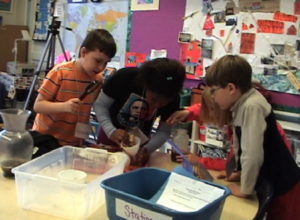 believed most children learned and achieved more in these informal, choice driven, indirect learning settings than settings that were more formal, rigid, and teacher-directed. That’s why they fairly hummed; EVERYone was cookin’. When these classes functioned well with proper degrees of structure and routine, they were the best of possible school worlds for children. Claire’s World, a recent video of one such still operative classroom, shows precisely what I mean. Taught by a deeply knowledgeable teacher, one might even say and instructional genius (Claire Oglesby), learning could be classically rich in these settings, often going so deeply into subject matter, driven of course by the children’s compounding interests, the teacher often had to just plain create and organized ending to the study so the school year could move on. I loved spending time in multiage classrooms where the conceptual development of children hell bent on investigating something of fascination was palpable. When a hush came over the classroom, I swear I could hear synaptic connections forming.
believed most children learned and achieved more in these informal, choice driven, indirect learning settings than settings that were more formal, rigid, and teacher-directed. That’s why they fairly hummed; EVERYone was cookin’. When these classes functioned well with proper degrees of structure and routine, they were the best of possible school worlds for children. Claire’s World, a recent video of one such still operative classroom, shows precisely what I mean. Taught by a deeply knowledgeable teacher, one might even say and instructional genius (Claire Oglesby), learning could be classically rich in these settings, often going so deeply into subject matter, driven of course by the children’s compounding interests, the teacher often had to just plain create and organized ending to the study so the school year could move on. I loved spending time in multiage classrooms where the conceptual development of children hell bent on investigating something of fascination was palpable. When a hush came over the classroom, I swear I could hear synaptic connections forming.
Multiage classrooms were on an up cycle when I came to higher education. Why? Trend analyses show that any time schools in the US appear to be auguring downward in someone’s perception of failure, proposals to alter school organization flood school policy discussions. The late 60s and 1970s were such a time. Spurred on by Sputnik and driven by a paranoid fear of losing cold war confrontations with the Soviet Union, school reorganization became one more societal change advocated during this era. These “failures” were seen as a decrease of intellectual capital due to the “rising tide of mediocrity” in out schools, so famously noted by Ronald Regan in 1983.
Why mixed age groupings
The idea of mixed age, family grouped children learning together in richly provisioned classrooms held an amazingly powerful symbolic attraction, especially the consideration of classroom groupings as “family”. Don’t forget, this was the era in education over which Jerome Bruner’s invocation that any child could learn any concept if that concept were properly presented (ie. developmentally “tuned”) held sway. This meant, of course, that failure to learn was in reality, mostly a failure to teach. Ideas like older siblings teaching their younger brothers and sisters, family groupings bonded together with warm affection across children of different ages, the emotions being seen as useful in the motivation of cognition (feelings at least accompanying if not provoking thinking, in other words), extended families supporting and nurturing the development of children, close collaborative ties between school and home; well, they were enough to fire anyone’s imagination of what could be and even should be, rather than what was.
Lady Plowden’s report
Schools in physical disrepair, school programs considered in need of renovation from the ground up, animosity between whites and blacks in the cities, ethnic prejudice everywhere, the glacial pace of school integration, gender discrimination in math and science learning opportunities, continued disparity among rich and poor with respect to income and school success, dismal performance on national assessments, all these dynamics drove an increasingly strident national call to do something, like reorganize the schools. It didn’t hurt, of course, that news from mother England carried with it stories of school success in huge industrial coal towns such as Birmingham that for years had failed their low income working class populations. The Plowden Report, England’s NCLB Act of 1967, an amazingly child-centered document, was studied extensively in this country. Surely, if there was a way to organize school programming that could reach working class English children, even those from bleak, depressed, coal smoked industrial cities, then such schooling could work here as well, or so the reasoning went. America’s naivety shown forth in its full glory. If the Brits could do it, then we could do it better. It didn’t hurt that urban models in this country, models like Lillian Weber’s Open Corridors Program in the heart of New York City were successful in emulating the ideas if not the actualities of the British Infant 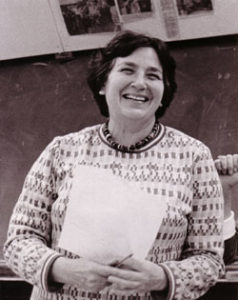 Schools. Of course the Open Corridor Program had Lillian Weber, a brilliant translator of the English model to the American reality. Way too many programs were started as transplants, trying to do exactly what the Brits were doing, programs implemented without a clue to the disparities in expectations coming out of the two cultures, driven by our youthful and ignorant enthusiasm for success.
Schools. Of course the Open Corridor Program had Lillian Weber, a brilliant translator of the English model to the American reality. Way too many programs were started as transplants, trying to do exactly what the Brits were doing, programs implemented without a clue to the disparities in expectations coming out of the two cultures, driven by our youthful and ignorant enthusiasm for success.
The question that was subtext to these efforts, of course, was, “In what kind of learning environment do children learn best?” Not a new question in American education. And from the perspective of 2005, perhaps not even the right question to ask. But in 1970, educational research was beginning to use new systems and protocols to think about how to research that question. The revolution in statistical analytical capability was just beginning to change the face and facility of educational research, forever, during this time. And more complicated computer models and observational protocols that utilized these computer models were coming on line every day. I was quite taken by one of these protocols and it gave me an angle on the learning process/achievement (aptitude/treatment interactions) relationship that provided a different kind of insight into the success potential of multiage classrooms. The observational protocol was called Flanders System of Interaction Analysis. Ned Flanders, a graduate student of Kurt Lewin, designed the system.
Ned Flanders and the analysis of verbal interaction
Interaction analysis allows you to keep track of ongoing interaction between two or more actors over a period of time. Flander’s system tracks verbal interaction between a teacher and her students. Heavily weighted towards teacher talk, Flanders’ system permits you to keep track of and chart the following categories of classroom talk over time:
Teacher Talk
1 = teachers statements that accept student feelings;
2 = teacher statements that praise and encourage;
3 = teacher statements that accept student ideas;
4 = teacher questions;
5 = teacher statements that lecture or give information;
6 = teacher statements that give directions;
7 = teacher statements that criticize or justify teacher authority;
Student Talk
8 = student statements that respond to a teacher question or comment;
9 = student statements that demonstrate student initiated thought or extended thinking;
10 = Silence and/or Confusion.
Combining Categories 1-3 created a measure of indirect teacher talk, while combining categories 4-6 created a measure of direct teacher talk. Interaction Analysis allowed researchers to record the type of verbal interaction every there seconds, then create a way to enter the chronological data into a matrix where anyone could see the patterns of verbal interaction that occurred over the course of the twenty to thirty minute observational period. A researcher could see how conversation happened in classrooms. Descriptive data was apparent for each of the ten categories. A researcher could begin to co-relate factors like student talk and achievement or teacher talk and achievement. You could see what it was teachers did before higher rates of student talk occurred. And on and on. It was new stuff for researchers interested in microanalyses of the moment to moment verbal interactions in the teaching learning process.
Interaction analysis was not a new research methodology. In 1951, Robert Bales and Fred Strodbeck authored what was perhaps the first system for analyzing small group interaction. Flanders extended their idea to the teaching/learning classroom arena. Thousands of studies of classroom teaching and learning in many countries around the world were conducted using Flanders’ system across all grade levels and content areas. In graduate school, we became so intimate with the categories, we used to have numbered conversations, just for the fun of it.
Flanders eventually carried out research linking interaction patterns to school achievement. Relatively high positive co-relational data associated indirect patterns of interaction with higher academic achievement and test scores. There was a certain degree of face validity to this research. In classrooms where children’s ideas were promoted and accepted with ample amounts of encouragement, you could see children processing  information more actively. Talking about what you were learning serves to consolidate and elaborate information. Naturally, if tested on this information, children who had the opportunity to actively process what a chain reaction meant as opposed to children who merely listened to teachers talk about a chain reaction, seemed to learn more. These findings, though disputed – not uncommon in educational research, especially with claims that attempt to link teaching style and student outcome – achieved a fair degree of notoriety across the decades of the seventies and eighties and it was in the midst of this wave of excitement that I arrived in Vermont.
information more actively. Talking about what you were learning serves to consolidate and elaborate information. Naturally, if tested on this information, children who had the opportunity to actively process what a chain reaction meant as opposed to children who merely listened to teachers talk about a chain reaction, seemed to learn more. These findings, though disputed – not uncommon in educational research, especially with claims that attempt to link teaching style and student outcome – achieved a fair degree of notoriety across the decades of the seventies and eighties and it was in the midst of this wave of excitement that I arrived in Vermont.
Multiage Up Close
As I looked at multiage classrooms, what I saw before me was what might be called an archetypical indirect teaching environment. In Flanders terminology, these were classrooms where verbal interactions were consistently more indirect. Teachers facilitated rich curricular investigations by children. Highly effective open (multiage) classrooms generated high rates of both teacher and student input. Teacher input was non-traditional. A table might have several sets of colored linking cubes upon it, each one an example of halfs but expressed in different mixed fractions (2/4, 4/8, 5/10, and so on). On the table would be a question: “What’s the same about these constructions? What’s different? Record your answers in a complete sentence. Find someone and compare your answers. Be prepared to share your answer in circle.” High teacher structure (the table was organized in a particular way for a particular outcome, the routines of investigation were firmly established) and high student structure (look, handle, discuss, write, present, defend) typified this seemingly obvious task. In situations such as these, students constructed multiple responses and found multiple ways to address the interesting questions that appeared before them. Passionate arguments would ensue, all supposedly ensuring that student understanding of the abstraction “one-half” would deepen (be understood and demonstrated in several different ways). The multiage classrooms I learned from in Vermont were classrooms that provoked learning because the mix of children of different ages guaranteed there would be ways of viewing questions that were both more primitive and sophisticated at the same time.
Overlapping complexity
This overlapping of complexity was rich indeed. It was the personification of the ideal mismatched environment that Hunt and a host of other cognitive psychologists advocated for healthy intellectual growth. It meant children could attack fairly sophisticated concepts at their own level of entry, while simultaneously seeing and hearing how other children pursued their solutions. Children could rehearse the creation of solutions for problems that were beyond their level just by looking on. Other children, in explaining their thinking, 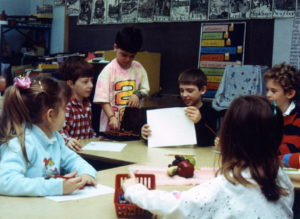 established deeper understanding for having to explain why they did what they did. Thinking was always propelled forward in those moments. And from Flanders’ perspective, what was going on was high rates of open ended questioning, accepting of student ideas, encouraging student work, and acknowledgement that this learning was both exciting and challenging and frustrating and joyful – accepting student feelings. These kinds of classrooms were where thoughts and feelings and actions moved together as one. Learners were whole human beings.
established deeper understanding for having to explain why they did what they did. Thinking was always propelled forward in those moments. And from Flanders’ perspective, what was going on was high rates of open ended questioning, accepting of student ideas, encouraging student work, and acknowledgement that this learning was both exciting and challenging and frustrating and joyful – accepting student feelings. These kinds of classrooms were where thoughts and feelings and actions moved together as one. Learners were whole human beings.
The fact that educators could ground these practices in the elaborate cognitive philosophies of Jean Piaget and later, Lev Vygotsky, provided a powerfully persuasive ethos to advocate for multiage practices. In Vygotskian terms, a multiage classroom was a zone of proximal development for all its learners. Anne Bingham, a multiage teacher in whose classroom I spent an entire semester conducting research on what successful multiage practice looked like, and her teammates over time created their own multiage culture and language, in short their own “zone”. I could hear it in the rituals and practices pursued by their children, every day of the week.
Explore Time under a microscope
One of my favorite times during the multiage day was a time known variously as explore, explore time, activity time, choice, or even free (horrors!) time. Still is, for those few remaining classrooms who have been able to hang on to “explore” in the face of absurdly unreasonable curricular demands. Functionally, it is a time during the day when children get to choose what it is they want to do and with whom they want to do it.
The concept by itself is enough to drive human beings who don’t think children can make good choices on their own behalf, and most certainly not good educational choices on their own behalf, nuts! They imagine, and probably can cite actual evidence imagined or otherwise, that as soon as Explore begins, kids turn into destructive monsters, jumping from game to game, running roughshod over each other, promoting all kinds of horrible chaos –what a favorite word to the denigrators of the open classroom movement. Teachers of explore time totally abrogate their academic duties for which they are graciously paid, leaving their children unattended to or worse, fully ignored. And so on, ad nauseum.
At the time, there were precious few books describing what excellent multiage practice, including explore time, looked like in American schools. So I decided to do something about it. I felt I’d cut my eye-teeth on coming to understand multiage in all its varieties. I hadn’t taught it, but I’d come close in all my observing and advising. During my second sabbatical at UVM, I decided to spend a semester studying and describing good multiage practice. My book, Multiage Portraits: Teaching and Learning in Mixed-Age Classrooms, came straight out of  this research. This book was simply an attempt to picture in words what good multiage practice looked like. Four superb teachers of multiage classrooms co-authored sections of Portraits with me. During this period of research, I looked closely at explore time. I was determined to show that far from the chaotic mess that often accompanied public diatribes against open classrooms, well functioning explore times were quite the opposite. They were times of intense focus and over time, in the minds of the students who had the good fortune to experience them, they became what was remembered as the best of this genre of classroom.
this research. This book was simply an attempt to picture in words what good multiage practice looked like. Four superb teachers of multiage classrooms co-authored sections of Portraits with me. During this period of research, I looked closely at explore time. I was determined to show that far from the chaotic mess that often accompanied public diatribes against open classrooms, well functioning explore times were quite the opposite. They were times of intense focus and over time, in the minds of the students who had the good fortune to experience them, they became what was remembered as the best of this genre of classroom.
What follows is part of a forty minute Explore Time taking place on March 20th, 1990. The description that follows comes directly from notes taken in Anne Bingham’s classroom on that Tuesday morning. But first, a little context about Anne’s room.
Anne and her teaching
Anne’s classroom was one of four large sunlit rooms on the first floor of the Shelburne Community School. The school fronted the main street of Shelburne perhaps less than a hundred yards from the town center. Four teachers comprise the multiage team for this school. As a team of four, they’d been teaching together for eight years and taught a K-3 span of age. 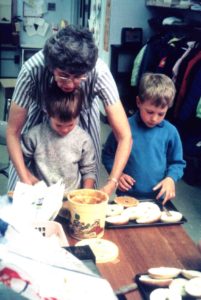 Each teacher had twenty children ranging in age from young fives to older eights in each of their four rooms. Ann and two of her partners had taught together for well over a decade and had been trained by Marion Stroud, an English “Headteacher” who had helped establish the Prospect School in North Bennington, VT. Their rooms were filled with a delicious variety of child tested games and puzzles and blocks and paints and worksheets and books and writing implements and, well, you get the picture. Children’s work was tastefully posted or displayed everywhere including the hallway outside the classroom doors. The work often illustrated a child’s solution to a problem or issue directly below the posting.
Each teacher had twenty children ranging in age from young fives to older eights in each of their four rooms. Ann and two of her partners had taught together for well over a decade and had been trained by Marion Stroud, an English “Headteacher” who had helped establish the Prospect School in North Bennington, VT. Their rooms were filled with a delicious variety of child tested games and puzzles and blocks and paints and worksheets and books and writing implements and, well, you get the picture. Children’s work was tastefully posted or displayed everywhere including the hallway outside the classroom doors. The work often illustrated a child’s solution to a problem or issue directly below the posting.
The team scheduled their Explore Time the same time every day of the week except Fridays. On Fridays, instead of Explore, they did a four-classroom assembly and sing-along. Once Explore began, children from each room could choose to go to any of the four multiage rooms. The rules were something like this: you must declare what you are going to do for explore time before leaving the opening circle, you can move to wherever space you want, you must respect each other’s space and property, no disrupting noise, you have to be able to explain what you are learning at any time a teacher asks, and you can do school work if you want to. Here’s what it looked like that Tuesday morning.
From the transcribed research journal expanded edition
I’m sitting in Ann’s room, watching the beginning of Explore Time. It’s 10:10am. Bright, warm, mid-morning sunlight floods in through the windows. Vermont Spring is trying desperately to arrive and so mornings are actually a little hot in this room because the large, old school windows face the sunny eastern sky. We are a little late beginning
Again I am struck at how well this collection of five, six, seven, and eight year old boys and girls get along with each other. There are very tall third graders here waiting their turn with very small and delicate five year old Kindergarteners. They’ve built solid relationships and know they have to respect each other’s person and property. Now Anne excuses them in pairs and in ones. Off they go! Their chatter as they head off is like the heavy plug on a pressure cooker releasing its load of steam. Even though the bird study was intensely fascinating, they were really ready to go! I’ll see the bird again, I’m sure. Anne had brought the Waxwing from home. The bird had broken its neck against her window and 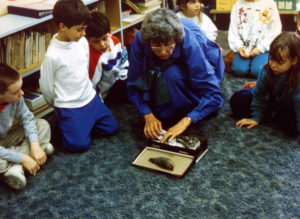 she’d stored it in her freezer until the right moment. The room is as it always is. There are clearly defined areas for large block play, small block play, reading and writing, painting, computer work, tables for constructive arts, and the rug space for practicing plays. A mix of coats chosen for a late winter’s day hang along the wall opposite the warming windows. Boots line up mostly in pairs, outside the door on the east edge of the long first floor hallway. It surprises me how many kids can be in the hallway at this time and not get enamored with playing kick the boot!
she’d stored it in her freezer until the right moment. The room is as it always is. There are clearly defined areas for large block play, small block play, reading and writing, painting, computer work, tables for constructive arts, and the rug space for practicing plays. A mix of coats chosen for a late winter’s day hang along the wall opposite the warming windows. Boots line up mostly in pairs, outside the door on the east edge of the long first floor hallway. It surprises me how many kids can be in the hallway at this time and not get enamored with playing kick the boot!
A snapshot of activities pursued
At 10:10
- Two third grade boys, one kindergarten boy and two kindergarten girls are working together with the unifix cubes. Their space is cramped. In a few minutes, one of the kindergarten girls moves on to play a board game with the teacher; the other moves one container of cubes to an empty adjacent table. She starts to play with them, exploring and investigating different ways of fitting them together. It looks like she is following a plan in her head but I don’t know what it is and I don’t want to interrupt her to ask; I think she watched some third graders make complicated constructions with them the day before, constructions where small cubes were hidden within hollow cubic constructions.
- Two second grade girls are playing with the legos on a yard square plywood building sheet toward the back wall. The building sheet is used so their construction can be moved all together in one piece so it can be contained just as it is and continued the next day. Lego constructions and big block constructions (when the center is open – it isn’t today) are the only constructions that can be left up over three or four days; leaving them up clearly allows for richer and deeper play.
- Two second grade boys and one kindergarten boy play Uno. The kindergarten boy joins the Unifix group after a short while.
- Two third graders, a boy and a girl, work on the computer; I’m not sure what they are doing. I’ll have to get over there.
- Two first grade boys paint on the easel, they joke and laugh quietly back and forth with each other; their painting continues a pattern of concentric circles that they were drawing yesterday; David finishes the painting he started the day before and leaves the easel.
- A kindergarten girl plays a board game with the teacher on the black board. This girl is joined by the girl who moved from the Unifix activity.
- Mallory, a third grade girl, reads a story to herself at one of the tables. She is so intent I don’t think she’d notice if an elephant strolled in the room. Maybe in her mind an elephant is strolling in the room. Maybe that’s why she’s so intent.
At 10:15
- The two boys, a kindergartener and a third grader, and the two girls, also a kindergartener and a third grader, continue to play with the cubes; Bart, the third grade boy, is basically fooling around. He is quite immature. He keeps grabbing Sean’s construction. Sean calls Anne, loud enough for Bart to hear but not for Anne to hear; Bart stops.
- Two second grade girls continue to play with the Legos;
- Two second grade boys continue to play Uno;
- One more third grade boy joins the computer crew;
- Two kindergarten girls are now painting; both boys have finished their work;
- A first grade girl now works with Anne on the board game; the game is really a conversion activity for measuring using the European system;
- Mallory continues on with her story. She’s actually frowning now.
At 10:20
- The two kindergarten children continue to work with the cubes; the two third graders end their involvement and join the computer crew;
- The two second grade girls continue to play with the Legos;
- The two second grade boys continue to play with Uno;
- One kindergarten girl continues to paint at the easel; the other joins the board game;
- Mallory continues on with her story.
So far, six children from other rooms have participated in activities in this room and seven children from this room are in one of the other three rooms.
At 10:25
- The two kindergarten children continue to work with the cubes;
- The two second grade girls continue to play with the Legos;
- Bonnie Douglas, special educator, comes in and takes one of the second grade Uno players out of the room so the Uno game ends. The other second grader leaves the room;
- Five third graders are now huddled around the computer, three are from other rooms;
- One kindergarten girl continues to paint at the easel;
- One kindergarten girl continues to play with Anne on the board game;
- The third grade girl continues on with her story.
At 10:30
- The cube play has ended;
- The two second grade girls are still at it with the Legos;
- The Uno game is over;
- The five are still huddled over the computer though they have switched who’s at the keyboard;
- The easel, story reading, and board game is as before; and,
- Two kindergarten boys have started to draw with markers.
And on it goes. No chaos here. Kids enter and leave the room not quite quietly but not in a manner that disturbs anyone. I hear it if kids are disturbing. The computer group is animated and having a good time playing Oregon Trail. Their noise is clearly within bounds. I know this because I’ve seen Anne look their way a couple of times but she doesn’t speak to them. The kids feel her eyes! The layered conversations are interesting. Most kids are involved in conversations about what they are doing. But few groups talk solely about what they are doing. They also carry on in parallel fashion, having the kind of peer-oriented friendly patter that children can have while they are doing something that doesn’t absolutely require talk solely about what they are doing. The flavor of these parallel conversations is all about what’s going on in other parts of their lives right now. And these conversations are being had across groups; groups defined by gender, groups defined by town/country distinctions, groups defined by income. Vacation coming up, what happened in gym yesterday, what they’ll do during lunch recess today, who will play what game with whom, a movie seen over the weekend, and so on. I notice lots of smiles flash across faces during this time, I hear giggles and laughter here and there, especially with Mallory reading that book – it must be funny now.
Explore Time as engaged activity
There’s little noticeable activity jumping during this forty-five minute explore time: the cubes were worked with for twenty minutes, the legos 40+ minutes, Uno 20 minutes until the special educator interrupted and stopped the game, the computer 40+ minutes, the painting easel was in use for twenty minutes, the measuring board game 40, the drawing 20, and the cutting and stapling 10 minutes.
Explore time charted out like this day after day. It was a time of significant continuity and routine. If anything the kids were involved in extended activity, activity far from the imagined idea some hold that explore time is nothing more than a noisy period of time filled with kids playing butterfly – flitting from activity to activity. If flitting went on, the teachers stepped in, usually involving the child in some work with them until they settled down. But on this day, my  chart has no “f” upon it indicating that in this room, anyway, no flitting was observed. I also note there is no off task behavior during Explore. This is especially significant when compared with another portion of the day, math time, a time of day when kids work independently in their math folders while Anne calls groups of children to work with her. My observations indicate that over another forty-five minute period of time, an average of five kids are off task or moving to a new activity during every three-minute chunk of time.
chart has no “f” upon it indicating that in this room, anyway, no flitting was observed. I also note there is no off task behavior during Explore. This is especially significant when compared with another portion of the day, math time, a time of day when kids work independently in their math folders while Anne calls groups of children to work with her. My observations indicate that over another forty-five minute period of time, an average of five kids are off task or moving to a new activity during every three-minute chunk of time.
Rarely did Explore Time take more than forty-five minutes. When it did, it was during a time the teachers used Explore to get ready for a larger event happening in Multiage. That event could be the preparation of materials for a parent’s night, it might be to get ready for a play, or it could be a wholly academic activity. For example, a teacher might decide pure and simply that more time was needed for math work. Explore was a flexible time period that could be taken for this kind of work. It happened rarely, but it happened.
Explore time as Gold
My observation concluded that Explore Time was worth its weight in gold. Years after, when adolescents and graduates were interviewed about their memories of multiage, what they remembered the most was Explore Time and the things they did during explore. Explore time carried with it lasting positive emotions for the children of multiage, at least this multiage team. In many ways, Explore Time epitomized what Multiage Classrooms came to mean not only to its advocates, but to the entire community. During my time there, the second generation of multiage children (children of the original children to go through multiage in its first years at Shelburne) were coming into multiage. Their parents talked about what a positive tone their time in these classrooms had set for their school experience. They asked if the end of the year camping trip still went on, if the teachers still held T-Shirt day, if the kindergarteners still made morning snack. Clearly, there were cultural rituals operating here, a culture with common rules, roles, and understandings that persisted in memory over time. New parents wanted their children to experience the same thing.
Why Multiage Worked – The Sadness of Its Loss
These days, it seems we have to justify anything we do in school according to whether or not it will lead to higher reading scores. If it doesn’t, we are soon to rid ourselves of it. If it does lead to higher scores, then we may do more of it. This is an unfortunate and misguided evolution in my mind. With ever increasing numbers of kids disassociating from the school experience, with dropout rates climbing higher and higher, ironically in the one state whose “success” was touted to have “inspired” this new accountability frenzy, with statewide testing programs increasing pressure on children and teachers to achieve at higher and higher rates, the idea that school should be a place where absorbing work happens has become an artifact of the past. Work now seems to be listen, write, correct, re-write, correct, hand in, get new work, and on it goes. Particularlistic, sequenced, low cognitive requirements for the most part, and highly repetitive. This is not school work that inspires happy memories of school. It is work that can rapidly become boring, for teachers and students.
It is work that inspired such enthusiasm in Anne’s room that unifies the hearts and souls and minds and spirits of children. In the last piece of writing I read about children’s development, work that inspires holistic integration such as this is a good thing. Having mind, body, and soul working together as one, strengthens the psyche and unifies a child’s identity. And teaching in a way that recognizes emotions as part and parcel of thinking, encourages children’s work, and accepts their academic ideas and builds from their self-generated interests, leads to higher achievement as well. At least Ned Flanders’ research would have us believe it is so.
Multiage and Graded settings
What made multiage so powerful for learning was the fact that by definition, the multiage classroom had differential norms of achievement. Every child didn’t have to be on the same page at the same time, by definition! It made natural sense to have differing norms of achievement because everyone accepts that children of different ages have (and should have) different capacities and capabilities. Learning at the highest possible rate for YOU was an important standard in multiage practice. It was okay to be academically different as long as you were progressing along in the right direction.
The room also was rich with rehearsal learning. Younger children could watch older children – in most cases but my no means exclusively the directionality of young to old – do what would soon be required of them. And Ann would allow it. Like the day when Peter and David watched Anne and Mallory think through the concept of multiplication using first the Unifix cubes, and then the Cuisenaire Rods and Squares. Peter and David were fascinated with the structuring of it all, the way the cubes showed the patterns of repeated additions. They couldn’t do it 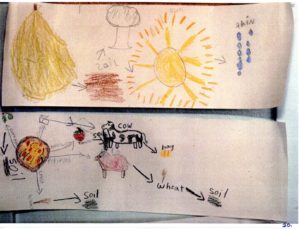 themselves, and they didn’t have to. But the next day they played with the same materials and tried to replicate the patterns. This kind of curiosity spawning, this opportunity to rehearse cognitively what is to come is a powerful lever in the learning atmosphere of this room. It pushes. Yet it pushes in a very safe and guarded way. It’s like a cognitive apprenticeship where the more accomplished pave a way for the less sophisticated to travel and once on the road, the less sophisticated may have a thing or two to show to their supposedly more accomplished friends.
themselves, and they didn’t have to. But the next day they played with the same materials and tried to replicate the patterns. This kind of curiosity spawning, this opportunity to rehearse cognitively what is to come is a powerful lever in the learning atmosphere of this room. It pushes. Yet it pushes in a very safe and guarded way. It’s like a cognitive apprenticeship where the more accomplished pave a way for the less sophisticated to travel and once on the road, the less sophisticated may have a thing or two to show to their supposedly more accomplished friends.
A single age classroom has quite a different set of norms inherent within it. The assumption there is that for second grade (for example), a standard exists that every second grader should be held up to. Pressure to succeed is built into the single age graded setting. There is more of a feeling that one size should be appropriate for all and if the shoe doesn’t fit, the fault lies elsewhere beyond the shoe. No wonder single grade schools continually produce children who fail at every grade level. The fact that every grade is leveled determines that a priori, we will have some children who don’t make it. What kind of sense does that make? It never made much actual sense to me. It still doesn’t. And to be honest, the accountability provisions of NCLB only magnify the issue. Case in point? Drop out rates in Texas have increased precipitously since the implementation of school programming upon which NCLB is based. So have retention rates at the ninth grade level. Kids are retained before the high stakes tests are given. They age, they never advance, and they drop out. Systems adjust to make themselves look good when stakes of a higher order are in play, even or especially at the expense of certain human lives.
Multiage declines with NCLB
Multiage settings are in steep decline with recent standards-based initiatives. Yes, multiage groupings remain in some schools. But they are hollow structures, structures adapted to ability-based initiatives, hollow where once heterogeneous groups of children learned from each other. Children are re-grouped several times during the day for ability-grouped math and ability grouped reading. What’s left? Not much except the affirmation that really, the only kind of learning that counts is that which strengthens your ability to read and compute. All else, all else like the minor subjects of science and social studies, for example, are extra.
Uninspired teaching and disaffected youth
After sixteen national workshops on Multiage practice, I stopped my travel on the lecture circuit. National initiatives had overtaken me and I could no longer in good conscience advocate a form of school organization that was going to disadvantage children given the way schools adopted required and graded curriculums in order to meet NCLB testing requirements. I believe the lack of unified, holistic, interest driven, child centered curricula in schools today drives the disaffection of young adults with their school experience. This inspired kind of teaching and learning can happen in single age/grade configurations, but it isn’t. We live in a time of psychic alienation from the academic pursuits we force pupils to endure. And we are paying the price as the numbers of unmotivated, resisting, even resentful and aggressive school children continue to rise. These figures are reflected in the dramatic rise in special education referrals, emotionally driven outbursts, school violence, dropout rates, as well as the rise in co-curricular participation and the professionalization of co-curricular activities for those who can afford it (this makes the drudgery of school more palatable for spectator and participant alike), and the increasing divergence of White and minority populations on almost every measure of school achievement.
These years were a fulfilling and inspiring time for me. As I went back and forth between conventional and multiage classrooms, I could see the motivational differences across the two settings. With good teaching, both could inspire and provoke learning. But consistently, it was the multiage environments that seemed to draw a wider range of children into its vortex of learning. There was more acceptance for difference in these rooms because by definition, it was the heterogeneity of the environment, the multiplicity of ways in which children learned because they were of different ages, that spawned the intensity of focus. Two lodestones in my own development as a teacher educator, the positive learning effect of mismatched groupings on such a wide scale, and noting higher achievement through the lenses that Flanders had so perceptively provided, neither of these made any difference as the political agenda turned to viewing our schools through the dark lenses of underachievement. Despite Berliner’s research to the contrary, A Nation At Risk turned America’s schools towards becoming, once again, wigit factories, learning factories of assembly line production, factories that worked for the few to the disadvantage of the many through the uninformed assumption that the problem of our supposed underachievement lay in an excess of teacher decision making. Yet, despite the overwhelming national despair about its educational system, my years of multiage involvement cemented in my brain the power of heterogeneity and dissonance as a force for learning.
